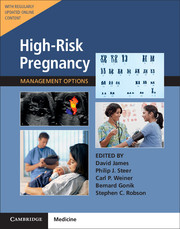Book contents
- Frontmatter
- Contents
- List of Contributors
- Preface
- Section 1 Prepregnancy Problems
- Section 2 Early Prenatal Problems
- Section 3 Late Prenatal – Fetal Problems
- Section 4 Problems Associated with Infection
- Section 5 Late Pregnancy – Maternal Problems
- 30 Substance Misuse in Pregnancy
- 31 Medication in Pregnancy
- 32 Hypertension in Pregnancy
- 33 Cardiac Disease in Pregnancy
- 34 Respiratory Disease in Pregnancy
- 35 Anemia and White Blood Cell Disorders in Pregnancy
- 36 Hematological Malignancies in Pregnancy
- 37 Thrombocytopenia and Bleeding Disorders in Pregnancy
- 38 Disorders of Coagulation in Pregnancy
- 39 Autoimmune Disease in Pregnancy
- 40 Diabetes in Pregnancy
- 41 Thyroid Disease in Pregnancy
- 42 Pituitary and Adrenal Disease in Pregnancy
- 43 Gastrointestinal and Liver Diseases in Pregnancy
- 44 Neurologic Complications in Pregnancy
- 45 Renal Disorders in Pregnancy
- 46 Spine and Joint Disorders in Pregnancy
- 47 Skin Disease in Pregnancy
- 48 Malignant Disease in Pregnancy
- 49 Pregnancy After Transplantation
- 50 Trauma in Pregnancy
- 51 Mental Health Disorders in Pregnancy
- Section 6 Late Prenatal – Obstetric Problems
- Section 7 Postnatal Problems
- Section 8 Normal Values
- Index
35 - Anemia and White Blood Cell Disorders in Pregnancy
from Section 5 - Late Pregnancy – Maternal Problems
- Frontmatter
- Contents
- List of Contributors
- Preface
- Section 1 Prepregnancy Problems
- Section 2 Early Prenatal Problems
- Section 3 Late Prenatal – Fetal Problems
- Section 4 Problems Associated with Infection
- Section 5 Late Pregnancy – Maternal Problems
- 30 Substance Misuse in Pregnancy
- 31 Medication in Pregnancy
- 32 Hypertension in Pregnancy
- 33 Cardiac Disease in Pregnancy
- 34 Respiratory Disease in Pregnancy
- 35 Anemia and White Blood Cell Disorders in Pregnancy
- 36 Hematological Malignancies in Pregnancy
- 37 Thrombocytopenia and Bleeding Disorders in Pregnancy
- 38 Disorders of Coagulation in Pregnancy
- 39 Autoimmune Disease in Pregnancy
- 40 Diabetes in Pregnancy
- 41 Thyroid Disease in Pregnancy
- 42 Pituitary and Adrenal Disease in Pregnancy
- 43 Gastrointestinal and Liver Diseases in Pregnancy
- 44 Neurologic Complications in Pregnancy
- 45 Renal Disorders in Pregnancy
- 46 Spine and Joint Disorders in Pregnancy
- 47 Skin Disease in Pregnancy
- 48 Malignant Disease in Pregnancy
- 49 Pregnancy After Transplantation
- 50 Trauma in Pregnancy
- 51 Mental Health Disorders in Pregnancy
- Section 6 Late Prenatal – Obstetric Problems
- Section 7 Postnatal Problems
- Section 8 Normal Values
- Index
Summary
Anemia: Overview
Anemia is defined as a hemoglobin value that is lower than the threshold of 2 standard deviations below the median value for a healthy matched population. The World Health Organization (WHO) defines anemia in pregnancy as a hemoglobin concentration of less than 110 g/L (11 g/dL), and postpartum less than 100g/L. The cutoff point suggested by the US Centers for Disease Control and Prevention (CDC) is the 5th percentile at a given gestation. In the second trimester this is 105 g/L.
Marked physiologic changes in the composition of the blood occur in healthy pregnancy (see Chapter 74). Increased total blood volume and hemostatic changes help to combat the hazard of hemorrhage at delivery. Plasma volume increases by 50%, and red cell mass by 18–25%, depending on iron status. These changes cause a physiologic dilution in hemoglobin concentration that is greatest at 32 weeks’ gestation. In ironreplete women, hemoglobin returns to normal by 1 week postpartum.
Worldwide, pathologic anemia is the most common medical disorder of pregnancy. Deficiency of essential hematinics usually arises from increased requirements and inadequate intake. Iron deficiency is the most common hematinic deficiency in pregnancy, followed by folate deficiency. Vitamin B12 deficiency rarely causes anemia in pregnancy.
In nonindustrialized countries, anemia is associated with up to 13% of maternal deaths. The global prevalence of anemia is 42%, but this ranges from 5% in the United States to more than 60% in parts of central Africa.
Anemia: Iron Deficiency
Maternal Risks
To maintain iron balance, women of reproductive age require 2 mg of iron daily. Pregnancy further stresses iron balance. The total iron requirements in normal pregnancy are approximately 1240 mg. The main demands for iron arise from expansion of the red cell mass (∼500–600 mg), and the fetus and placenta require approximately 300 mg. The daily iron requirement in pregnancy is approximately 4.4 mg (0.8 mg/day in the first trimester, increasing to 7.5 mg/day in the third trimester). If a woman enters pregnancy with depleted iron stores, the effects of iron deficiency develop. Vegetarians are at an additional disadvantage owing to a lack of heme iron in the diet. Absorption of iron is less than 10%, so an average of 40 mg of dietary iron is required daily.
As iron deficiency develops, the ferritin level decreases first and then the serumiron level.
- Type
- Chapter
- Information
- High-Risk Pregnancy: Management OptionsFive-Year Institutional Subscription with Online Updates, pp. 974 - 1005Publisher: Cambridge University PressFirst published in: 2017



